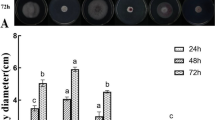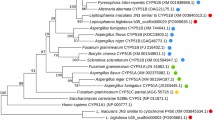Abstract
Fungicide resistance to crop protection products is a critical sustainability issue in modern agriculture that requires constant monitoring of the field situation considering different environmental conditions and agricultural practices. Regulation strategies based on resistance risk ranking of both pathogen and active compound, underpinned by fast and broad field monitoring, shall result in recommendations for suitable practices with the aim to stabilize or even to restore the sensitivity situation. Alternating and mixing various products according to their modes of action belong to the most common and the most efficient mitigation methods. Though, these resistance management measures can be implemented best when precise knowledge of both the molecular target and the cell biology of the pathogen as well as of the resistance mechanism is acknowledged. To this end, we have investigated the molecular target and cellular effects of fluopicolide, one of the most effective Oomyceticides in the market. By combining data of genomic analysis of resistant field isolates of Plasmopara viticola and Phytophthora infestans with UV-mutagenized strains of P. infestans, we identified the enzyme vacuolar H+-ATPase as the target protein. Biochemical assays confirmed that fluopicolide inhibits specifically Oomycetes targets and has no residual activity on true fungi or insect orthologs.

Similar content being viewed by others
Data availability
Sequence data are accessible via GenBank database (PRJNA962816).
References
Ali A, Kumar R, Mazákova J, Maňasová M, Zouhar M, Pánek M (2022) Evaluation of the ability of seven active ingredients of fungicides to suppress Phytophthora cactorum at diverse life stages, and variability in resistance found among isolates. J Fungi 8:1039. https://doi.org/10.3390/jof8101039
Alva AK, Lanyon LE, Leath KT (1985) Influence of fungal-soil water interactions on phytophthora root rot of alfalfa. Biol Fert Soils 1:91–96. https://doi.org/10.1007/BF00255135
Anonymous (n.d.) OPSDiagnostics. https://opsdiagnostics.com/notes/protocols/ctab_protocol_for_plants.htm
Anonymous (2022) Resistance status and resistance management recommendations for fungicides not covered in current FRAC working groups or expert fora, FRAC
Blum M, Waldner M, Gisi U (2010) A single point mutation in the novel PvCesA3 gene confers resistance to the carboxylic acid amide fungicide mandipropamid in Plasmopara viticola. Fungal Genet Biol 47:499–510. https://doi.org/10.1016/j.fgb.2010.02.009
Bolger AM, Lohse M, Usadel B (2014) Trimmomatic: a flexible trimmer for Illumina sequence data. Bioinformatics 30:2114–2120. https://doi.org/10.1093/bioinformatics/btu170
Bowman EJ, O’Neill FJ, Bowman BJ (1997) Mutations of pma-1, the gene encoding the plasma membrane H+-ATPase of Neurospora crassa, suppress inhibition of growth by concanamycin A, a specific inhibitor of vacuolar ATPases. J Biol Chem 272:14776–14786. https://doi.org/10.1074/jbc.272.23.14776
Bowman EJ, Graham LA, Stevens TH, Bowman BJ (2004) The bafilomycin/concanamycin binding site in subunit c of the V-ATPases from Neurospora crassa and Saccharomyces cerevisiae. J Biol Chem 279:33131–33138. https://doi.org/10.1074/jbc.M404638200
Bradford MM (1976) A rapid and sensitive method for the quantitation of microgram quantities of protein utilizing the principle of protein-dye binding. Anal Biochem 72:248–254. https://doi.org/10.1016/0003-2697(76)90527-3
Chen Y, Chi H-Y, Meesapyodsuk D, Qiu X (2013) Phytophthora infestans cholinephosphotransferase with substrate specificity for very-long-chain polyunsaturated fatty acids. Appl Environ Microbiol 79:1573–1579. https://doi.org/10.1128/AEM.03250-12
Cherrad S, Hernandez C, Steva H, Vacher S (2018) Resistance of Plasmopara viticola to complex III inhibitors: a point on the phenotypic and genotypic characterization of strains. 12e Conférence Internationale sur les Maladies des Plantes, 11 et 12 décembre 2018, Tours, France 449–459, Végéphyl
Cho CW, Fuller MS (1989) Observations of the water expulsion vacoule of Phytophthora palmivora. Protoplasma 149:47–56. https://doi.org/10.1007/BF01623982
Cotado-Sampayo M, Ramos PO, Perez RO, Ojha M, Barja F (2008) Specificity of commercial anti-spectrin antibody in the study of fungal and Oomycete spectrin: cross-reaction with proteins other than spectrin. Fungal Genet Biol 45:1008–1015. https://doi.org/10.1016/j.fgb.2008.02.003
Dai T, Yang J, Zhao C, Zhang C, Wang Z, Peng Q, Liu P, Miao J, Liu X (2024) Unveiling vacuolar H+-ATPase subunit a as the primary target of the pyridinylmethyl-benzamidefungicide, fluopicolide. J Agric Food Chem 72(3):1527–1538. https://doi.org/10.1021/acs.jafc.3c08485
Fontaine S, Remuson F, Caddoux L, Barrès B (2019) Investigation of the sensitivity of Plasmopara viticola to amisulbrom and ametoctradin in French vineyards using bioassays and molecular tools. Pest Manag Sci 75:2115–2123. https://doi.org/10.1002/ps.5461
FRAC “Code List©”, 2022: Fungal control agents sorted by cross-resistance pattern and mode of action (2022), FRAC
FRAC pathogen risk list (2019), FRAC
Genet J-L, Vincent O (1999) Sensitivity of European Plasmopara viticola populations to cymoxanil. Pestic Sci 55:129–136. https://doi.org/10.1002/(SICI)1096-9063(199902)55:2%3c129::AID-PS884%3e3.0.CO;2-H
Gisi U, Waldner M, Kraus N, Dubuis PH, Sierotzki H (2007) Inheritance of resistance to carboxylic acid amide (CAA) fungicides in Plasmopara viticola. Plant Pathol 56:199–208. https://doi.org/10.1111/j.1365-3059.2006.01512.x
Hayek S, Lee S, Parra K (2014) Advances in targeting the vacuolar proton-translocating ATPase (V-ATPase) for anti-fungal therapy. Front Pharmacol 5:74246
Heaney SP, Hall AA, Davies SA, Olaya G (2000) Resistance to fungicides in the Qol-STAR cross-resistance group: current perspectives. In: The BCPC conference: pests and diseases, Volume 2 Proceedings of an international conference held at the Brighton Hilton Metropole Hotel, Brighton, British Crop Protection Council, UK, 755–762
Kikway I, Keinath AP, Ojiambo PS (2020) Temporal shifts in sensitivity of Pseudoperonospora cubensis populations in response to cucurbit downy mildew fungicides, APSNET
Koledenkova K, Esmaeel Q, Jacquard C, Nowak J, Clément C, Ait Barka E (2022) Plasmopara viticola the causal agent of downy mildew of grapevine: From its taxonomy to disease management. Front Microbiol 13:889472
Lacourt I, Panabières F, Marais A, Venard P, Ricci P (1994) Intraspecific polymorphism of Phytophthora parasitica revealed by analysis of mitochondrial DNA restriction fragment length polymorphism. Mycol Res 98:562–568. https://doi.org/10.1016/S0953-7562(09)80480-2
Langmead B, Salzberg SL (2012) Fast gapped-read alignment with Bowtie 2. Nat Methods 9:357–359. https://doi.org/10.1038/nmeth.1923
Leroux P, Clerjeau M (1985) Resistance of Botrytis cinerea Pers. and Plasmopara viticola (Berk. & Curt.) Berl. and de Toni to fungicides in French vineyards. Crop Prot 4:137–160. https://doi.org/10.1016/0261-2194(85)90014-6
Massi F, Torriani SF, Waldner-Zulauf M, Bianco PA, Coatti M, Borsa P, Borghi L, Toffolatti SL (2023) Characterization of Italian Plasmopara viticola populations for resistance to oxathiapiprolin. Pest Manag Sci 79:1243–1250. https://doi.org/10.1002/ps.7302
Michels L, Bronkhorst J, Kasteel M, de Jong D, Albada B, Ketelaar T, Govers F, Sprakel J (2022) Molecular sensors reveal the mechano-chemical response of Phytophthora infestans walls and membranes to mechanical and chemical stress. The Cell Surface 8:100071. https://doi.org/10.1016/j.tcsw.2021.100071
Mounkoro P, Michel T, Benhachemi R, Surpateanu G, Iorga BI, Fisher N, Meunier B (2019) Mitochondrial complex III Qi-site inhibitor resistance mutations found in laboratory selected mutants and field isolates. Pest Manag Sci 75:2107–2114. https://doi.org/10.1002/ps.5264
Nelson N, Perzov N, Cohen A, Hagai K, Padler V, Nelson H (2000) The cellular biology of proton-motive force generation by V-ATPases. J Exp Biol 203:89–95. https://doi.org/10.1242/jeb.203.1.89
NGS-Based CLD & Biosafety | Genedata Selector (n.d.)
Parada-Rojas CH, Quesada-Ocampo LM (2022) Phytophthora capsici populations are structured by host, geography, and fluopicolide sensitivity. Phytopathology 112:1559–1567. https://doi.org/10.1094/PHYTO-09-21-0403-R
Penouilh-Suzette C, Fourré S, Besnard G, Godiard L, Pecrix Y (2020) A simple method for high molecular-weight genomic DNA extraction suitable for long-read sequencing from spores of an obligate biotroph oomycete. J Microbiol Methods 178:106054. https://doi.org/10.1016/j.mimet.2020.106054
Phytophthora_infestans - Ensembl Genomes 55 (n.d.)
Piazza I, Beaton N, Bruderer R, Knobloch T, Barbisan C, Chandat L, Sudau A, Siepe I, Rinner O, de Souza N, Picotti P, Reiter L (2020) A machine learning-based chemoproteomic approach to identify drug targets and binding sites in complex proteomes. Nat Commun 11:4200. https://doi.org/10.1038/s41467-020-18071-x
Rakotonindraina T, Chauvin J-É, Pellé R, Faivre R, Chatot C, Savary S, Aubertot eN, (2012) Modeling of yield losses caused by potato late blight on eight cultivars with different levels of resistance to Phytophthora infestans. Plant Disease. https://doi.org/10.1094/PDIS-09-11-0752
Rane HS, Bernardo SM, Hayek SR, Binder JL, Parra KJ, Lee SA (2014) The Contribution of Candida albicans vacuolar ATPase subunit V1B, encoded by VMA2, to stress response, autophagy, and virulence is independent of environmental pH. Eukaryotic Cell 13:1207–1221. https://doi.org/10.1128/EC.00135-145
Van Rossum, Guido, and Drake FL (2009) Python 3 Reference Manual, CreateSpace, 100 Enterprise Way, Suite A200 Scotts Valley CA.
Siegenthaler TB, Hansen ZR (2021) Sensitivity of phytophthora capsici from tennessee to mefenoxam, fluopicolide, oxathiapiprolin, dimethomorph, mandipropamid, and cyazofamid. Plant Disease 105:3000–3007. https://doi.org/10.1094/PDIS-08-20-1805-RE
Thomas A, Neufeld KN, Seebold KW, Braun CA, Schwarz MR, Ojiambo PS (2018) Resistance to Fluopicolide and Propamocarb and baseline sensitivity to Ethaboxam among isolates of Pseudoperonospora cubensis from the eastern United States. Plant Dis. https://doi.org/10.1094/PDIS-10-17-1673-RE
Toquin V, Barja F, Sirven C, Gamet S, Mauprivez L, Peret P, Latorse M-P, Zundel J-L, Schmitt F, Lebrun M-H, Beffa R (2009) Novel tools to identify the mode of action of fungicides as exemplified with fluopicolide. In: Chet I, Gullino ML (eds) Recent developments in management of plant diseases (Gisi U. Springer, Dordrecht, pp 19–36. https://doi.org/10.1007/978-1-4020-8804-9_2
Toquin V, Latrose MP, Beffa R (2019) Fluopicolide: a new anti-oomycete Fungicide? Modern crop protection compounds. Wiley, Hoborken, pp 871–878
Tröster V, Setzer T, Hirth T, Pecina A, Kortekamp A, Nick P (2017) Probing the contractile vacuole as Achilles’ heel of the biotrophic grapevine pathogen Plasmopara viticola. Protoplasma 254:1887–1901. https://doi.org/10.1007/s00709-017-1123-y
Tu H, Wang Z, Nosyreva E, De Smedt H, Bezprozvanny I (2005) Functional characterization of mammalian inositol 1,4,5trisphosphate receptor isoforms. Biophys J 88:1046–1055. https://doi.org/10.1529/biophysj.104.049593
Wang L, Ji P (2021) Fitness and competitive ability of field isolates of Phytophthora capsici resistant or sensitive to fluopicolide. Plant Dis 105:873–878. https://doi.org/10.1094/PDIS-08-20-1729-RE
Wang W, Yan L, Meng R, Zhao J, Zhang X, Han X, Ma Z (2014) Sensitivity to fluopicolide of wild type isolates and biological characteristics of fluopicolide-resistant mutants in Pseudoperonospora cubensis. Crop Prot 55:119–126. https://doi.org/10.1016/j.cropro.2013.09.012
Wu TD, Watanabe CK (2005) GMAP: a genomic mapping and alignment program for mRNA and EST sequences. Bioinformatics 21:1859–1875. https://doi.org/10.1093/bioinformatics/bti310
Acknowledgements
We would like to acknowledge Julie Morel, Anja Niggemeier, Rebecca Boessen, and Judith Doroy for their support in DNA preparation and biochemical assays as well as Andrea Perez Villa for sequence alignment and Marc Rist for his guidance.
Author information
Authors and Affiliations
Corresponding author
Ethics declarations
Conflict of interest
All authors are employees of Bayer AG or Bayer S.A.S.
Consent to publication
In this manuscript, the enzyme vacuolar H+ -ATPase is described as a target to control Oomycetes and is identified as the biochemical target of fluopicolide. Most importantly, this research work uses fluopicolide-resistant field isolates as a starting point for the mode of action elucidation work instead of the conventional approach of solely analysing laboratory mutants. Finally, this paper reports for the first time on fluopicolide-resistant field isolates of Phytophthora infestans.
Additional information
Publisher's Note
Springer Nature remains neutral with regard to jurisdictional claims in published maps and institutional affiliations.
Supplementary Information
Below is the link to the electronic supplementary material.
Rights and permissions
Springer Nature or its licensor (e.g. a society or other partner) holds exclusive rights to this article under a publishing agreement with the author(s) or other rightsholder(s); author self-archiving of the accepted manuscript version of this article is solely governed by the terms of such publishing agreement and applicable law.
About this article
Cite this article
Peyrard, S., Di Vietro, L., Essigmann, B. et al. Fluopicolide is a selective inhibitor of V-ATPase in oomycetes. J Plant Dis Prot (2024). https://doi.org/10.1007/s41348-024-00908-y
Received:
Accepted:
Published:
DOI: https://doi.org/10.1007/s41348-024-00908-y




